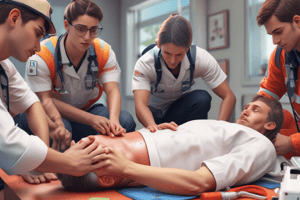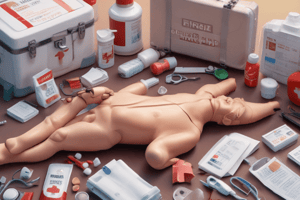Podcast
Questions and Answers
What is the first step in the LLF protocol?
What is the first step in the LLF protocol?
- Listen to the sound of air coming from the mouth or nose
- Look for the rise and fall of the chest (correct)
- Check for definitive pulse at Carotid area
- Feel the Carotid pulse
Which area should be checked for a definitive pulse in an adult or child according to the LLF protocol?
Which area should be checked for a definitive pulse in an adult or child according to the LLF protocol?
- Carotid pulse (correct)
- Radial pulse
- Brachial pulse
- Femoral pulse
In the context of assessing for severe bleeding, what should you look for?
In the context of assessing for severe bleeding, what should you look for?
- Blood pressure reading
- Blood-soaked clothing (correct)
- Pupil size
- Temperature of extremities
What can untreated shock lead to?
What can untreated shock lead to?
Which of the following does the text NOT suggest as a method to gain essential information about a patient's medical history?
Which of the following does the text NOT suggest as a method to gain essential information about a patient's medical history?
What does the LLF protocol recommend checking for when assessing a victim's primary airway?
What does the LLF protocol recommend checking for when assessing a victim's primary airway?
What does the 'A' stand for in the AVPU mnemonic used to summarize a patient's response level?
What does the 'A' stand for in the AVPU mnemonic used to summarize a patient's response level?
During primary assessment, what is the first step after checking the patient's responsiveness?
During primary assessment, what is the first step after checking the patient's responsiveness?
In a CARE FIRST situation, what type of emergencies are often related to?
In a CARE FIRST situation, what type of emergencies are often related to?
What does the 'U' stand for in the AVPU mnemonic used for assessing responsiveness?
What does the 'U' stand for in the AVPU mnemonic used for assessing responsiveness?
Which technique should be employed to check an unconscious person for breathing?
Which technique should be employed to check an unconscious person for breathing?
Why is it important to call first in CARDIAC emergencies?
Why is it important to call first in CARDIAC emergencies?
What is a key characteristic of a good first aider based on the text?
What is a key characteristic of a good first aider based on the text?
What is an essential quality for a first aider to have when handling a victim?
What is an essential quality for a first aider to have when handling a victim?
How can infectious diseases be transmitted according to the text?
How can infectious diseases be transmitted according to the text?
What is one of the common transmittable diseases mentioned in the text?
What is one of the common transmittable diseases mentioned in the text?
What should a first aider prioritize when approaching a scene for emergency action?
What should a first aider prioritize when approaching a scene for emergency action?
What is the importance of body substance isolation (BSI) in first aid?
What is the importance of body substance isolation (BSI) in first aid?
Flashcards
LOOK, LISTEN, and FEEL
LOOK, LISTEN, and FEEL
A technique using sight, sound, and touch to check for breathing. Look for chest rise and fall, listen for air from the nose and mouth, and feel for breath on your cheek.
Carotid Pulse
Carotid Pulse
A pulse located on the side of the neck, used to check for circulation.
Shock
Shock
A condition characterized by a rapid heartbeat, low blood pressure, and pale skin, often caused by blood loss or injury.
SAMPLE
SAMPLE
Signup and view all the flashcards
AVPU
AVPU
Signup and view all the flashcards
Assessing Responsiveness
Assessing Responsiveness
Signup and view all the flashcards
Scene Size-up
Scene Size-up
Signup and view all the flashcards
Activating Medical Help
Activating Medical Help
Signup and view all the flashcards
Automated External Defibrillator (AED)
Automated External Defibrillator (AED)
Signup and view all the flashcards
Gentle
Gentle
Signup and view all the flashcards
Resourceful
Resourceful
Signup and view all the flashcards
Observant
Observant
Signup and view all the flashcards
Tactful
Tactful
Signup and view all the flashcards
Emphatic
Emphatic
Signup and view all the flashcards
Respectable
Respectable
Signup and view all the flashcards
Universal Precautions
Universal Precautions
Signup and view all the flashcards
Body Substance Isolation (BSI)
Body Substance Isolation (BSI)
Signup and view all the flashcards
Personal Protective Equipment (PPE)
Personal Protective Equipment (PPE)
Signup and view all the flashcards
Study Notes
Primary Assessment
- Use the LOOK, LISTEN, and FEEL technique to check for breathing, air coming from the mouth or nose, and the rise and fall of the chest.
- Feel the Carotid pulse for 10 seconds to check for circulation.
Bleeding and Shock
- Quickly look for severe bleeding from head to toe.
- Check for signs of shock, as it can lead to death if left untreated.
Secondary Assessment
- Interview the person and bystanders to gather information.
- Check the person from head to toe, and check vital signs.
- Use the SAMPLE approach to ask questions: Signs & Symptoms, Allergies, Medications, Pertinent past medical history, Last intake & output, and Events leading up to injury or illness.
Assessing Responsiveness
- Use the AVPU mnemonic to assess a patient's response level: Alert, Response to Voice, Response to Pain, Unresponsive/Unconscious.
- Assessing responsiveness is the first step in primary assessment.
Activating Medical Help
- Call for local emergency number and get an Automated External Defibrillator.
- Provide information: what happened, location, number of people injured or ill, cause and extent of injury, and first aid given.
- Identify yourself and hang up the phone last.
Characteristics of a Good First Aider
- GENTLE: avoid causing or adding pain to the patient.
- RESOURCEFUL: make the best use of available resources.
- OBSERVANT: notice all signs and be aware of what is happening.
- TACTFUL: handle the victim with care and in a calm manner.
- EMPHATIC: be comforting.
- RESPECTABLE: maintain a professional and caring attitude.
Health Hazards and Risks
- Common transmittable diseases: Herpes, Meningitis, Tuberculosis, Hepatitis, HIV/AIDS.
- Disease transmission can occur through direct contact, indirect contact, and airborne transmission.
Prevention and Protection
- Universal Precautions: take precautions to prevent the spread of diseases.
- Body Substance Isolation (BSI): isolate bodily substances to prevent transmission.
- Personal Protective Equipment (PPE): use equipment to prevent transmission.
Emergency Action Principles
- Scene Size-up: assess the scene for safety, cause of injury, and number of casualties.
Studying That Suits You
Use AI to generate personalized quizzes and flashcards to suit your learning preferences.




